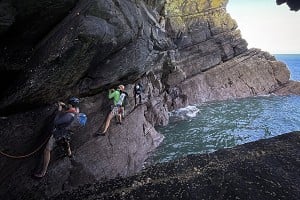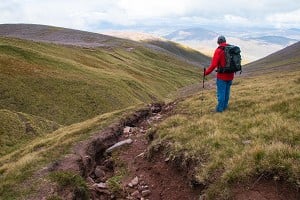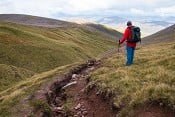
Ahead of the one-hundredth anniversary of George Mallory and Andrew Irvine's disappearance on Everest on 8 June, author Mick Conefrey reflects on Mallory's life and mysterious death and shares an extract from his newly-published book, Fallen.
In 1920 George Mallory was a charismatic teacher at a British public school with a small but intense circle of friends and admirers. By the end of 1922 he was the most famous climber in Britain, an in-demand public speaker and a published author. Two years later, he was missing presumed dead after his last, failed attempt on Everest and the most famous climber in the world. Like all the millions of young men and women who had been killed during the Great War, he was elevated into the ranks of the glorious dead, forever entombed near the summit of Everest, 'the finest cenotaph in the world' according to his friend and fellow climber Howard Somervell.
Even though Edmund Hillary and Tenzing Norgay were the first men to reach the summit, George Mallory is just as famous, his name forever associated with Everest and the mystery of whether he and his protégé Sandy Irvine died on the way up or on the way down. Like James Dean, Jim Morrison and Jimi Hendrix he's one of the good who died young, and in the years since his disappearance, a powerful mythology has grown up around him, generating countless books and articles, and several expeditions. It's easy to see the roots of the myth: Mallory was handsome and charismatic, a brilliant climber and a skilled orator. His name was his destiny: George, the dragon Slayer, Mallory, an unconscious echo of Thomas Malory, the first chronicler of the Arthurian legend. Mallory was the beating heart of three British expeditions, the climber kept on pushing forward when others would have turned back but was he driven by ego-mania and so called 'summit fever', or was he as team-mate Edward Norton 'the most formidable opponent that Everest has or is ever likely to encounter'?
In many ways, Mallory was a typical middle class British mountaineer. The son of a clergyman, he learned to climb at Winchester public school, went on to Cambridge and then began working as a teacher at Charterhouse, another public school. During the First World War he served as an artillery officer before returning home to pick up his career as a teacher. In 1921 Everest beckoned when he was invited to join the British team making the first ever reconnaissance. After that he was invited back in 1922 and 1924. So much, so typical, but in many other ways Mallory was very different from the other soldiers and Alpine Club men who joined him on those expeditions.
For one thing, his friends were varied and unconventional: Duncan Grant, the painter, Lytton Strachey the historian, Robert Graves the poet, John Maynard Keynes, the economist, Rupert Brooke, the poet. Many of them were drawn from the so called Bloomsbury group of artists and intellectuals who fell in an out of love with each-other, dreamed of personal and cultural revolution and of making a name for themselves. Aged 22, Mallory fell in love with James Strachey, the brother of Lytton Strachey, the flamboyantly gay historian and author of 'Eminent Victorians'. Age 27, Mallory fell in with Ruth Turner, the daughter of the Arts and Crafts architect, Hugh Thackeray Turner, and had three children with her.
Mallory's own artistic streak came out in his writing. In his famous essay 'The Mountaineer as Artist', he tried to explain how a mountaineering expedition could be compared to a great symphony with all its emotional highs and lows. For the 1922 official Everest account, he penned one of the most lyrical descriptions of a mountain ever written, describing how it emerged from the mist like a "preposterous triangular lump….now one fragment, now another through the floating rifts, until far higher in the sky than imagination had dared suggest the white summit of Everest appeared". Mallory was hopeless with most technical things, whether they were Primus stoves or cameras, but he was a gifted writer who wrote essays about the artistry and aesthetics of mountaineering.
Climbing, however, was not Mallory's only passion. Even though now he is so closely associated with Everest, he only joined the British expeditions at the last moment in both 1922 and 1924 after a lot of soul searching. He had other things to do. A socialist Fabian, he wanted to join the League of Nations, introduce a new type of private school, solve the problem of Irish Home Rule and bring up his family as best as he could.
When he finally got to the Himalayas, however, it all changed. On an expedition his focus was absolutely singular: to get to the top of the mountain. He wasn't interested in Tibetan culture, he didn't want to collect Himalayan flowers and fauna, all he wanted to do was get to the top. In 1924, his much younger climbing partner, Andrew Irvine, regularly complained to his diary that Mallory got up too early, exercised too hard, and yomped up the glaciers far too quickly.
In both 1922 and 1922, it was Mallory who agitated for a third attempt after the first two summit bids had been unsuccessful, but in both years the results were ultimately disastrous. In 1922, seven porters died in an avalanche just below the North Col with Mallory and the British climbers a few feet above them. In 1924 Mallory himself disappeared high on the mountain, after making a questionable decision to take Andrew Irvine with him even though he was the least experienced climber on the team. Mallory's flaws were obvious to those around him. After the avalanche in 1922, the expedition doctor, Tom Longstaff, called him a 'great stout hearted baby' and the expedition leader, Charles Bruce, questioned his judgement noting that he was a 'great dear but he forgets his boots on all occasions'. When Mallory returned for the third time in 1924, he was easily the most experienced climber on the British team, but he wasn't even made deputy expedition leader.

And yet for all his flaws and his slightly chaotic style, Mallory's charisma and his obsessive pursual of the summit won over his detractors at the time and ensured that he would have plenty of future admirers. In comparison to Robert Falcon Scott, who died during the Race to the South Pole, history has been kind to Mallory, his image relatively unscathed, his failings forgiven, his mysterious end adding to his fascination.
When his body was found high on Everest in 1999, he was once again front-page news, the world holding its breath, willing his discoverers to find proof that he had indeed reached the summit. In they end they didn't and for next two decades there were repeated attempts to find the body of his young partner, Andrew Irvine, in the hope that he might be carrying the elusive Vest-pocket Kodak that might contain evidence that they had stood on the top of the world together, 29 years before Hillary and Tenzing.
Today that search has more or less come to an end after several further, but fruitless search expeditions. In the latest twist to the saga, it's claimed that Irvine's body and the elusive camera were spirited off the mountain by the Chinese authorities, never again to see the light of day. But if the possibility of finding photographic proof has evaporated, does that mean that no-one believes he could have reached the summit? Absolutely not.
On the 100th anniversary of his disappearance and death, Mallory is once again back in the headlines, with new books, events, statues and conferences celebrating his short but eventful life. A Hollywood movie has been on and off the cards for the last ten years and there's even a full-blown musical doing the rounds, 'Mallory and the Mountain'. It's unlikely that it's going to knock 'Chicago' or 'Moulin Rouge' off the Broadway top ten list, but the fascination with Mallory remains. Even if definitive proof may never be found that he reached the top of Everest, it's equally impossible to prove that he didn't reach the top.
Like all great legends, Mallory is continually re-invented by new generations of mountaineers and acolytes: in the 1920s he was 'Galahad of Everest', the reincarnation of an Arthurian knight, the 1990s he epitomised striving and the spirit of adventure, a climber who was so at one with Everest, that his muscular body had literally become part of the mountain. As his wife Ruth wrote in a poignant letter, shortly after his death in June 1924: "I never owned him. I never even wanted to. We all had our own part of him. My part was tenderer and nearer than anyone else's but it was only my part."
Extract from Fallen: George Mallory: The Man, The Myth and the 1924 Everest Tragedy.
On 3 May, accompanied by Irvine, Odell and Hazard, Mallory set off at the head of the first party of twenty Sherpas, aiming to hump the stores left by the local Tibetans up to Camp 3. It was a bitterly cold and windy day, the sky overcast with heavy, threatening clouds. Mallory was the only veteran of 1922. Irvine was planning to go with him as far as Camp 3, and the two other new boys, Odell and Hazard, were going to carry on up 1,700 feet higher to the North Col to establish Camp 4, the jumping-off point for the summit attempts.
The route followed a narrow trail that ran between huge piles of rock, or lateral moraines, on the left-hand side of the Rongbuk glacier. Though in theory most of the supplies and equipment should have gone up already, Mallory noticed that several of the Sherpas seemed to be carrying very heavy loads, with their own belongings and bedding perched on top of the sahibs' precious oxygen bottles.
At Camp 1, no tents were needed. Instead, both the sahibs and the Sherpas slept in sangars, the rough low-walled shelters made from rocks gathered nearby that they had put up in 1922. The next morning, after a few hours reorganizing the Sherpas' loads and abandoning anything that wasn't totally necessary, Mallory once again led them out of camp, the rocky trail continuing up the lateral moraine before moving onto the glacier itself.
Mallory had 'a devil in him', as Irvine wrote in his diary, setting a furious pace which left his young partner breathless. Before they had set off from Base Camp, Somervell had taken blood samples from everyone to see how they were adapting to the altitude. Irvine had been pleased to see that he had the highest concentration of red corpuscles – vital to carry oxygen around the body – but he admitted in his diary that he found the going very tough, comparing keeping up with Mallory with competing in the Boat Race.
Just after midday, they reached Camp 2, next to the frozen lake. It was 'extraordinarily uninviting', as Mallory later wrote to Ruth. The sahibs and the Gurkha NCOs had tents, but the Sherpas had to scavenge for more rocks to build new sangars, topping them with tent flysheets to keep a little warmer. Mallory was shocked at how unenthusiastic they seemed, apparently so overwhelmed by the conditions that they did not care about their own creature comforts.
He had brought a Hindustani grammar to help him communicate, but Mallory never bonded with the Sherpas and in his letters home rarely mentioned any of them by name. Though like everyone else he admired their hardiness, he was very critical of how easily they seemed to lose heart when conditions got tough, often comparing them to children. In comparison to the previous expeditions, the Sherpas hired in 1924 were better clothed and equipped, but they hadn't been issued with the same quality of boots as Mallory and the sahibs and had to provide their own inner clothing. Carrying heavy loads across the freezing cold Rongbuk glacier, it's easy to see how they might have become 'listless', in Mallory's words.
The next morning, the real problems started. It had been an appalling night, with heavy snow, strong winds and the temperature dropping to –17 degrees Celsius. Everyone emerged from their tents late, and three of the Sherpas said they felt so bad that they couldn't carry on. After a long noisy argument between Mallory and one of the 'old soldiers' over what he should carry, which climaxed with Mallory threatening him with his fist in his face, they finally got away at 11.00 a.m.
The going was extraordinarily difficult. The wind had blown most of the snow cover off the ice, leaving it rock hard and even more slippery. Occasionally between icy pinnacles there were piles of fresh, powdery snow, but nothing that offered a good grip. The expedition had brought crampons, but they hadn't been issued yet, so everyone moved achingly slowly. Mallory did the route-finding, occasionally falling back to the rear to check up on everyone and urge them on.
A few hundred yards later, they reached a trough in the ice, about fifty feet deep, that Mallory remembered from 1922. On clear sunny days it could become intolerably hot and airless, prompting a strange 'glacier lassitude', but mercifully that morning the Trough was cloudy and overcast. It was crevasse-free, but with the porters still moving slowly, they roped up into three parties, a 'device' that Mallory hoped would help pick up the pace, even though there was no real need. When they emerged a few hours later, the wind was behind them, but when they passed Changtse, a lesser mountain in the Everest massif, the wind changed direction and hit them full on, slowing the Sherpas to a crawling pace.
Powering ahead of Irvine, Odell and Hazard, Mallory reached Camp 3 alone. It was, he confided to Ruth, a 'queer sensation reviving memories of that scene, with the dud oxygen cylinders piled against the cairn which was built to commemorate the seven porters killed two years ago'. It must have been a very uncomfortable moment, being reminded of all the guilt that he felt for the failure of the third attempt in 1922. This time, as he wrote in a letter to his sister Mary, 'It will be my job to get the party off the mountain in safety… No one, climber or porter, is going to get killed if I can help it.' But now, with the sun going down and the temperature dropping, he was under no illusions about how miserable the coming hours would be.

- ARTICLE: 100 Years of Everest Gear 14 Apr, 2022
- ARTICLE: Kangchenjunga - The Last Great Mountain 25 May, 2020
- John Hunt - The Forgotten Hero of Everest? 14 Nov, 2012
















Comments
I've always wondered if the snow conditions in 1924 were such that the second step was banked out, possibly on the unseen side, which would have enabled them to by-pass the steep rock pitch. It fits with the description of them disappearing behind the step and re-appearing shortly after above it. Modern Everest must be a very different mountain due to climate change than it was in 1924.
Four people in the photo, which one is Mallory?
Standing, Irvine in the hat, Mallory beside him, cut off beside Mallory is Norton, and sitting are Shebbeare and Bruce
Thank you. I'm loving Mallory's punk haircut!
Why is your foot on Edward's shoulder George?
George: "Because it's right there!"